Many pediatricians agree that feeding a baby at 5 months should be based on mother's breast milk or artificial mixtures. But if a very active baby does not eat up, then parents have a completely logical question, what can you feed a child at 5 months, so as not to harm his health.
We introduce complementary foods at 5 months
In the days of our mothers and grandmothers, it was believed that complementary foods for a 5-month-old baby should start with juices and fruits. This is not entirely true, because raw fruits and juices are very difficult for the child's body. In addition, they can cause allergies in a baby whose liver is not ripe for taking such products. complementary foods in early age it is better to start with monocomponent vegetable purees, kefir or cereals.
Many parents find it difficult to decide which product to start complementary foods with. If the baby has a problem with weight, then it is better to first introduce cereals into complementary foods, they are rich in useful elements and contribute to good satiety of the baby. But also cereals can "strengthen" the child, so if you have problems with stools, start complementary foods with another product. Kefir is the closest in composition and taste to milk for babies, so many pediatricians recommend starting complementary foods with this product. Vegetable purees are very well absorbed by the body, rich in vitamins and microelements. If you decide to start complementary foods with vegetables, then pumpkin, zucchini and cauliflower are best suited for the first foods.
Sample menu for a 5 month old baby
The menu of a child at 5 months should not be varied, on the contrary, the slower you start introducing new foods, the less likely you are to develop allergies.
Even in ancient times, our grandmothers and great-grandmothers began to introduce babies to adult food at the age of one month. At this stage, the parents gave the child juice and introduced egg yolk into the diet. All this was explained quite simply. Women needed to get to work as soon as possible. They could not sit with a baby until three years old, as is possible now. That is why there was a need for premature introduction of the baby to the adult environment.
Now everything has changed a lot. Experienced pediatricians and doctors say that children food should be useful in the first place. What could be better than mother's milk? It is this product that is able to give the child the necessary portion of vitamins and nutrients necessary for the normal growth and development of all systems.
First food
Than 5.5 months? Most experts will answer this question in the following way. The main food for the baby during this period is breast milk. However, it is perfectly acceptable to start introducing Kasha it will be or vegetable puree- depends on the individual characteristics of the child's body. Be sure to consult with a specialist and find out what exactly to give your baby in the first place.
Many breastfeeding mothers say that baby food at the age of five or six months should be exclusively natural. With adult food, you need to introduce the baby only after a year. It should be noted that this is not entirely correct. No one is forcing you to deprive your baby of natural food. However, the first complementary foods should be introduced no later than six months. Otherwise, it will be much more difficult for the child to adapt to the world around him and improve digestion.

How can a child's nutrition be: store-bought goods and homemade products
First of all, the baby's food should be fresh and varied. Be sure to consider the benefits and harms of certain products. Currently, you can buy absolutely any food for your crumbs in the store. This includes vegetable puree, cereals, soups fast food, fruit treats, curds and so on.
You can also prepare a meal for your child yourself. In this case, you need to choose only healthy products and, after careful processing, grind them. If you pay attention, you may notice that ready-made baby food does not contain salt and artificial sweeteners. This must be taken into account when preparing a dish on your own.
baby at 5 months
At this age, the baby is awake for about 8 hours. At the same time, his games are interrupted several times a day by sound sleep. If just a few months ago the baby fell asleep while sucking on his mother’s breast or eating from a bottle, now everything has changed a little. Most often, the baby eats immediately after waking up. After that, it's time for active games, training and gymnastics. After the next sleep and rest, the baby again needs a portion of food.
About four or five hours a baby at this age can go without food. The baby eats about one liter of mother's milk per day. If you add additional foods to your diet, then the amount of natural food consumed may be slightly reduced. You can clearly see how a 5-month-old baby is fed. A table of the daily routine and an exemplary menu is presented to your attention. Keep in mind that all data can be considered conditional. The diet of each baby is individual.

Children's feeding table
This form is in every children's clinic. If you wish, you can ask your pediatrician to provide you with this information. The table indicates that each product should be introduced gradually and very carefully.
If the baby has overweight and is gaining body weight quite well on mother's milk, then complementary foods begin with fruit puree or vegetable substances. In this case, the first ingredients are zucchini, broccoli, cauliflower, apples and pears. At least two weeks are allotted for the introduction of each component. Only after the baby is completely accustomed to a new food, you can begin to get acquainted with the next dish.
When the baby is not gaining weight well (provided that the child is 5 months old, artificial nutrition), complementary foods can be introduced a little earlier. In this case, doctors recommend starting with porridge. The very first cereals for crumbs should be the following: buckwheat, millet, rice. They also need to be introduced gradually. The very first dish should be prepared without the use of milk. Later, you can add this component to increase the calorie content of porridge.
The table for children says that you can give your child soups up to a year. At the same time, the components of the dish should already be familiar to the baby. If the baby has problems with stool, then it is advisable to add olive oil and beets to his diet. With frequent bowel movements, offer the crumbs more rice dishes.

Diet for a 5 month old baby
How to feed a child 5.5 months? Depending on your desire and the health of the baby at this age, one or two feedings may well be replaced. However, it is not forbidden to completely refuse complementary foods during this period. How to feed a child 5.5 months? Consider a possible diet for infants.
First meal or breakfast
Immediately after waking up in the morning, the baby will require a portion of food. It can be breast milk in an amount of about 200 milliliters. Often, mothers want to soak up the bed longer and it’s easier for them to breastfeed their baby than to run to the kitchen and cook breakfast.
If you formula feed your baby, the natural nutrition is replaced by an adapted milk formula. The amount of food remains the same (200 milliliters). However, some babies may eat a little more. Do not conform to generally accepted standards. If your child needs 300 milliliters of milk or 150, then give him that much.
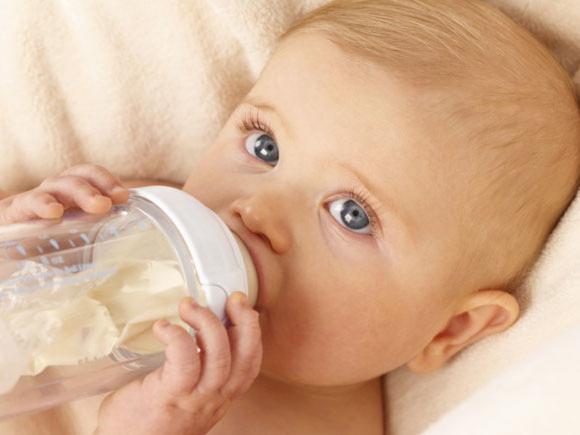
Second meal
This process most often occurs in the afternoon. Many moms position it with breakfast. You can give the baby milk porridge at this time. If you are just starting weaning, then New Product should be entered during these hours. This method will allow you to closely monitor the child's reaction to the new ingredient.
If you wish, you can give the baby natural food - mother's milk. If you are completely satisfied with such a diet, then no one insists on the forced introduction of porridge. It is worth recalling that a child can eat about 100 milliliters of a cereal product.
Third meal or lunch
If the baby is familiar with many vegetables, then you can offer him a soup. To do this, all ingredients are thoroughly cleaned and boiled. After that, the mass is crushed with a blender and oil is added to it. Such food for a child should be in the amount of 50-100 milliliters.
After dinner, be sure to offer milk, formula, or plain water. Fluid in his body should come in unlimited quantities.
Afternoon or lunch
Often, mothers give fermented milk products to the baby during this meal. Pediatricians also note that curd products should be introduced only when the baby is six months old. However, according to indications, you can start offering adapted curds to your baby right now. The amount of the product should not exceed 25-30 grams per day.
Kefir is an excellent substitute for infant formula. If you offer your baby this drink, then stick to the volume limit of up to 150 milliliters. Some children may consume more, but at this age there are often problems with digestion and increased gas formation.
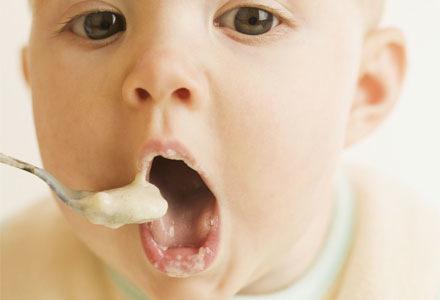
What to give the baby for dinner?
At 5.5 months, the crumbs dinner should consist of an adapted mixture or breast milk. Many mothers try to feed their child more high-calorie and satisfying food. Women hope that after such a meal the baby will sleep longer. However, this opinion is erroneous. After a heavy dinner, a child's sleep can be very poor. Undigested food will remain in the stomach throughout the night. This will cause discomfort and pain in the peritoneum.
Give your child their usual food before going to bed. If you are breastfeeding, offer your baby natural feeding. Let the baby suckle until he is full. At artificial nutrition the volume of the milk mixture should not exceed 300 milliliters. Such food quickly saturates the body of the crumbs and allows him to fall asleep with a sweet dream.

Night feedings
Many babies at the age of five months still wake up at night for another snack. This is not a pathology. What to feed the child in this case? Undoubtedly, breast milk or prepared mixture. Surely mothers will not think that at this time you can give your child soup or porridge. Such food should be postponed until the morning.

Summing up, or a small conclusion
You now know exemplary nutrition baby at 5 months (menu). Do not look up to your friends, neighbors or relatives. If your baby at this age is still unfamiliar with adult food, while the neighbor is already eating pasta with sausages with might and main, there is nothing to be ashamed of. Adjust to the desires of your crumbs. If he shows interest in adult food, then you should let him try new foods. Most likely, the baby will like the unusual taste of a variety of dishes. At the same time, you can continue breastfeeding as you wish.
Feed your baby not only tasty, but also make sure that the baby's diet is varied and filled with nutrients. In this case, the baby will develop correctly and delight you with its success.
Most babies are ready to taste something other than breast milk or formula by the age of five months. When the baby has grown to complementary foods, parents have a lot of questions that we will try to answer in this article.
Many pediatricians recommend introducing complementary foods into the child's diet, starting from 5 months. What can be given to taste such little child and what to avoid like fire - main question for parents of 5 month old babies. To see a smiling baby provide him with proper nutrition. Let's figure out what kind of diet a child needs at this age.
Diet plan for a 5 month old baby
At 5 months, the baby still receives the main food in the form of mother's milk. During this period, you can also add a few tablespoons of vegetable puree. Baby needs to be fed 5 times a day - every 4 hours.
We provide sample menu, which you can use as a guide:
- Second breakfast - mashed potatoes with fruits or vegetables, half an egg yolk
- Lunch - breastfeeding, 10 g cottage cheese, 30 g natural juice
- Dinner - breastfeeding, 30 g juice
Second menu option could be like this:
- Breakfast - breastfeeding
- Second breakfast - porridge, which must be boiled in milk, juice and cottage cheese in a ratio of 3: 1
- Lunch - breastfeeding, mashed apples or pears
- Late Dinner - Breastfeeding
If the child is on IV, then the diet will be as follows: - Breakfast - a glass of kefir
- Second breakfast - porridge boiled in milk, cottage cheese and fruit puree 1: 1.5
- Lunch - a glass of kefir or a mixture, 30 g of juice
- Dinner - vegetable puree, half yolk, 30 g juice
- Late dinner - a glass of kefir or a mixture
At this age, it's time to feed the child with milk porridge - buckwheat, semolina or rice. You can also mix these cereals, thus increasing the usefulness of the meal. It will be useful to add vegetables and fruits to cereals. For 2 weeks you will need to increase the initial portion from 30 g to 150 g.
Video: 5 feeding mistakes
How to introduce complementary foods at 5 months while breastfeeding?
Feeding a child who is on breastfeeding, should be entered from 6 months. But if you think that already at 5 your baby meets the following criteria, then you can introduce complementary foods into the diet a little earlier:
- Baby asks for more food
- The baby's weight has doubled since birth.
- The baby sits with the help of an adult and holds his head well
- The baby does not push solid food out of the mouth
- The child is not sick for more than 14 days

Introduce complementary foods to a child with HB according to these rules:
- Feed your baby only with a teaspoon (not metal)
- Do not give the baby large portions and do not force him to eat what is offered if he resists.
- Give a new product quite a bit, because the child may have an allergic reaction. In addition, small portions, with their gradual increase, will allow the baby's stomach to get used to previously unknown food.
- Write down in a notebook all the foods that you give your baby, as well as the body's reaction to new foods.
- Sit your baby in a high chair while feeding
- After a new product, introduce the next one no earlier than 3 days later, so that the child’s stomach gets used to food gradually
- Supplement your baby with breast milk while weaning

How to introduce complementary foods at 5 months on artificial feeding?
With IV, introduce complementary foods according to a specific pattern. Doctors advise introducing complementary foods with IV no earlier than at 4.5 months. Let's look at all the nuances of the introduction of complementary foods:
- The child should not get sick during the introduction of complementary foods
- Start with apple juice, no more than ½ tsp
- Feed the old formula first, then the new food
- The baby should only eat while sitting.
- Grind foods until the child learns to chew well
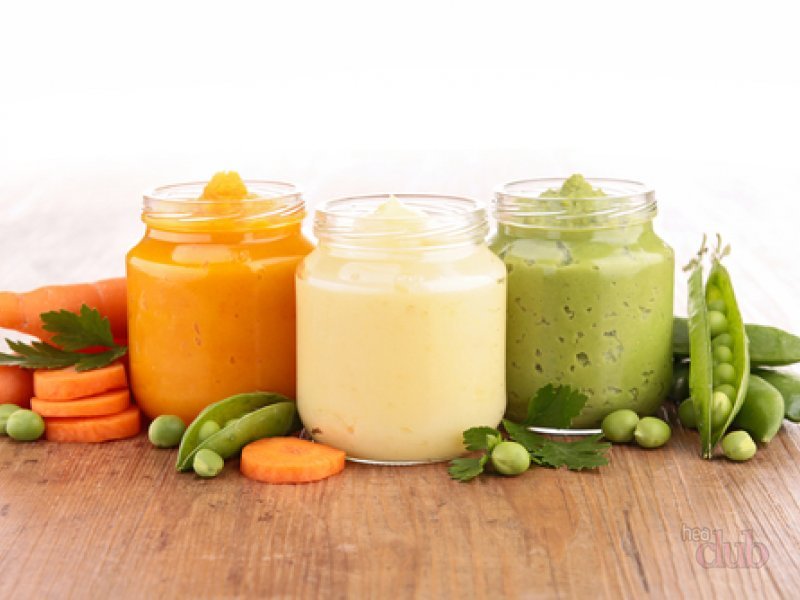
- After juice, continue feeding fruit puree, first also apple
- Next, enter the vegetables - broccoli, cauliflower, zucchini and pumpkin
- A child on IV must drink boiled water
- Give your child boiled or baked fruits and vegetables. At first, give only fruits, after 10-14 days you can add vegetables. Fruits should be given in the morning and evening, vegetables in the afternoon.
Video: Lure. Komarovsky E.O.
How much vegetable puree should a 5 month old baby eat?
The best option for complementary foods for the baby at first is fruit and vegetable puree, as well as porridge. Fruit puree should be given last, because after the sweet mixture, the child is unlikely to want to taste the tasteless porridge or vegetables.
Initially, the baby must be introduced into complementary foods completely some vegetable puree literally ½ tsp, gradually increasing the portion. For starters, zucchini puree is an excellent option, this product should be given to the child for at least 7 days, and after that, switch to a new vegetable.
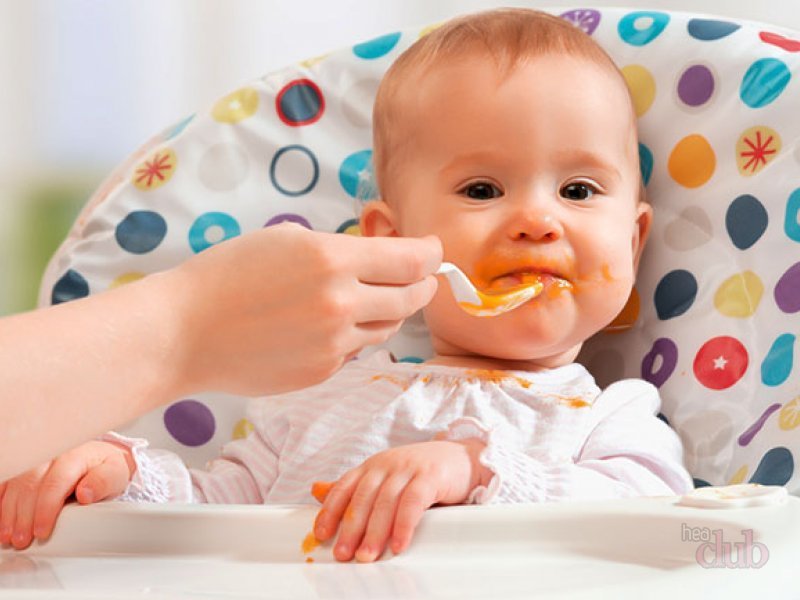 Vegetable puree in the child's diet precedes fruit
Vegetable puree in the child's diet precedes fruit After a week, add 1 tsp of mashed potatoes to the zucchini broccoli or cauliflower. The next product could be a pumpkin. After the child gets used to each vegetable, the best option would be a combination of three ingredients.
The optimal portion of vegetable puree for a child is 3 tsp 1-2 p. day.
What kind of porridge and how can I give at 5 months?
For children on HB, introduce porridge into the diet no earlier than at 5 months, for IV - 4.5 months. The rules for introducing porridge into complementary foods are as follows:
- To start, enter porridge gluten free. Firstly, such cereals are better digested, and secondly, there is a very rare disease - gluten allergy. Therefore, for starters, let's rice, corn or buckwheat porridge
- If the child is used to every porridge, then you can start mixing them after all, there is a lot of vegetable protein in rice, buckwheat - useful mineral salts and iron, and corn porridge - vitamins and microelements and fiber
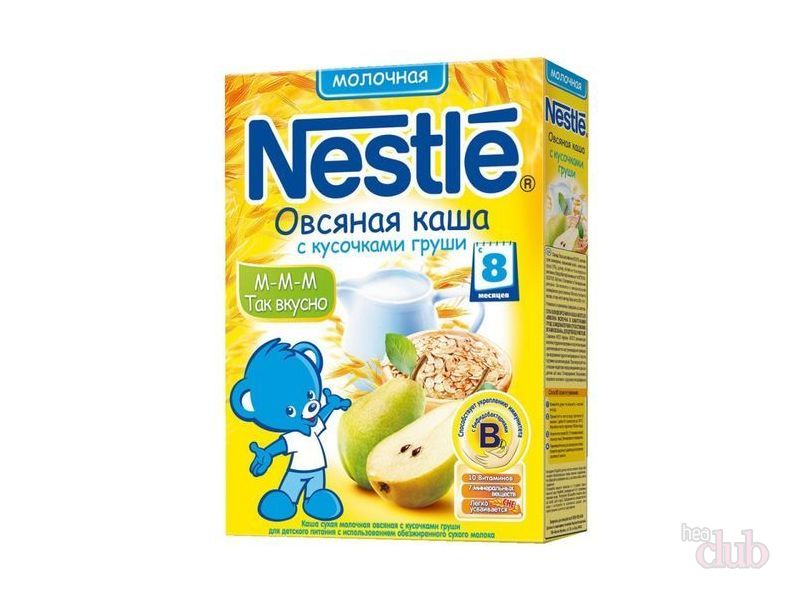 You can also use special fast-cooking porridge as a complementary food, which is now produced in a huge amount.
You can also use special fast-cooking porridge as a complementary food, which is now produced in a huge amount. - To begin with, do not add fruit, honey, or other additives to the porridge. This can be done when the child gets used to grains
- In order for the child to get used to cereals better, first introduce porridge boiled in water. From the first days, give 1 tsp of porridge, then gradually increase the portion to 150 g in 10 days
- If the child feels well, then increase the amount of porridge to 10 g
- Give porridge in the morning before breastfeeding or formula
- From the first to the fourth day, increase the serving by 5 g, then by 30 g and from the fifth by 50 g. On the 7th day, you should get required 150 g
Kasha can be of three types:
- ordinary cereals, which are ground at home with a coffee grinder. They need to be cooked
- instant cereals that do not require cooking
- prepared canned cereals containing fruits, vegetables or milk
Diet plan for a 5 month old baby
If the baby does not have enough mother's milk at 5 months, then you should try introduce complementary foods into the diet. Start with vegetable puree, then add juices with fruit pulp, then taste fruit purees shki.
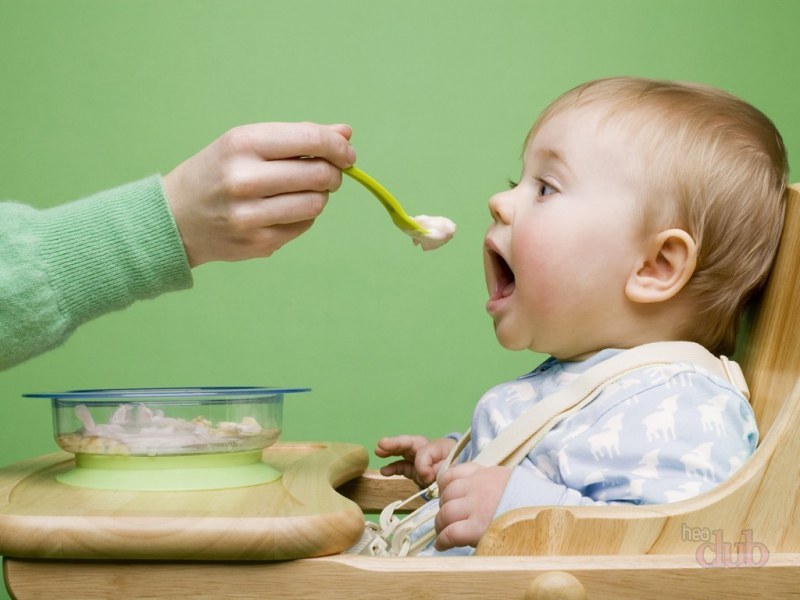
An excellent option for complementary foods would also be the pulp of an apple - peel and gently scrape a little pulp with a spoon for the baby.
The next products should be bananas and pears. When the child gets used to each fruit separately, you can combine them.
Now there is a huge selection in stores puree in jars. But still, if you have the opportunity to purchase ripe fruits, then it is better to make mashed potatoes yourself using a blender. In this case, there will be more benefits and vitamins in the finished product.
 You can also give the crumbs store-bought fruit purees. At the same time, please contact Special attention product shelf life and packaging integrity
You can also give the crumbs store-bought fruit purees. At the same time, please contact Special attention product shelf life and packaging integrity Children up to a year do not advise to give grape juice, since he often has allergies and problems with the intestines. The remaining fruit juices should be given starting with ½ tsp, gradually increasing the portion up to 4 tsp.
Menu for a child at 5 months: feeding schedule by day
We offer you an approximate optimal option for complementary foods at 5 months. In the first week start with zucchini:
- Monday - 5 g zucchini and GW
- Tuesday - 10 g zucchini and GV
- Wednesday - 20 g zucchini and GW
- Thursday - 50 g zucchini and GW
- Friday - 80 g zucchini and GW
- Saturday - 120 g zucchini and GW
- Sunday - 150 g zucchini
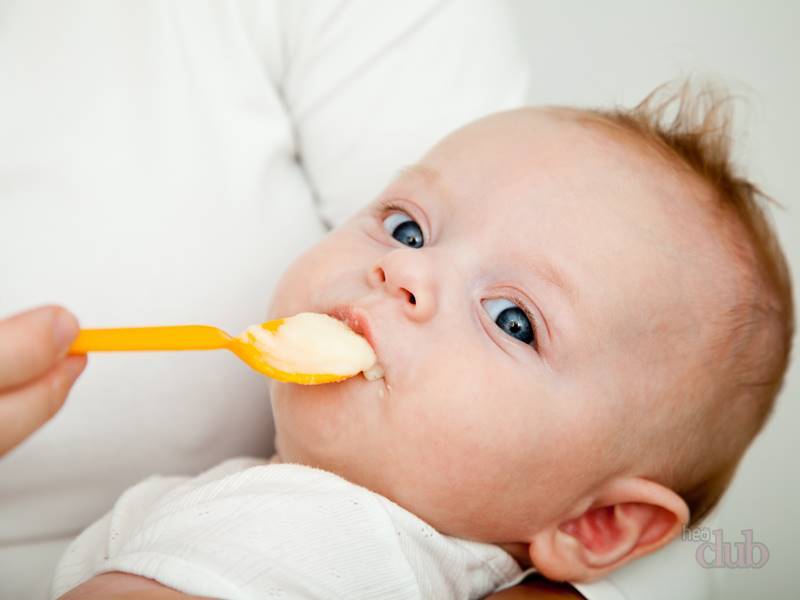 Once you've introduced complementary foods, don't stop breastfeeding.
Once you've introduced complementary foods, don't stop breastfeeding. Start the second week add cauliflower:
- Monday - 5 g zucchini and 140 g cabbage
- Tuesday - 10 g zucchini and 130 g cabbage
- Wednesday - 20 g zucchini and 110 g cabbage
- Thursday - 50 g zucchini and 50 g cabbage
- Friday - 70 g zucchini and 80 g cabbage
- Saturday - 150 g cabbage
- Sunday - 150 g cabbage
From the third week it's time for the broccoli
- Monday - 5 g broccoli 140 g colored
- Tuesday - 130 g zucchini and 10 g broccoli
- Wednesday - 20 g broccoli and 130 g colored
- Thursday - 50 g broccoli and 100 g zucchini
- Friday - 80 g broccoli and 70 g cauliflower
- Saturday - 150 g broccoli
- Sunday - 150 g zucchini
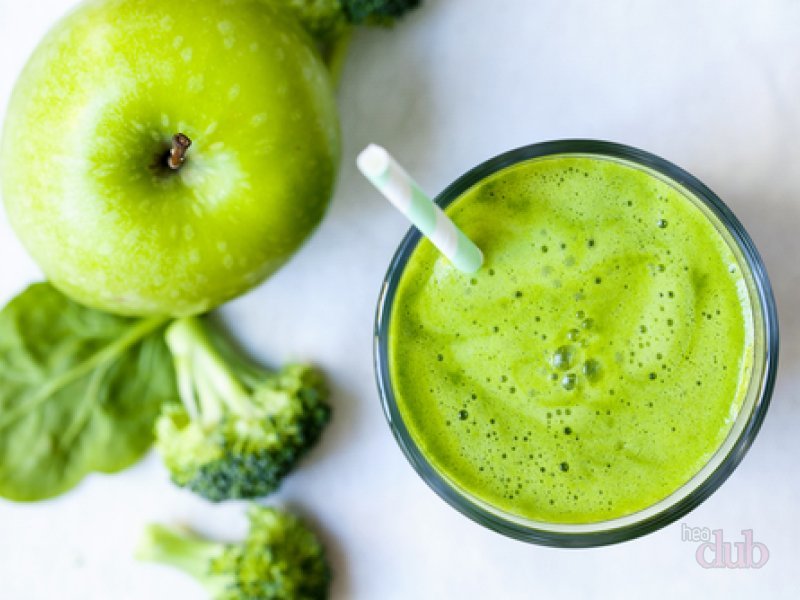
Last week enter pumpkin:
- Monday - 5 g pumpkin 140 g broccoli
- Tuesday - 10 g pumpkin and 140 g cauliflower
- Wednesday - 20 g pumpkin and 130 g zucchini
- Thursday - 50 g pumpkin and 100 g broccoli
- Friday - 80 g pumpkin and 70 g cauliflower
- Saturday - 150 g pumpkin
- Sunday - 150 g broccoli
Don't force the child if he refuses to eat broccoli or pumpkin now. Divide the meal into several meals or try feeding him in a playful way.
 If the child refuses to try a new food for him, then you should not insist - postpone the tasting for a while
If the child refuses to try a new food for him, then you should not insist - postpone the tasting for a while Important: Be sure to consult your pediatrician before introducing complementary foods.
If your child completely ready to eat at the age of five months, then try to give the child the best, because the safer and more useful the proposed products are, the your baby will grow healthier. If your pediatrician insists that you take your time with complementary foods, then follow his instructions and continue to enjoy the period of breastfeeding.
Video: Child development at 5 months
At 5 months, babies grow noticeably, become more active, inquisitive and interested. Surrounding objects are increasingly attracting attention, the child seeks to study and examine them closer. Emotional reactions become more diverse: laughter appears, a smile addressed to parents and those who often spend time with the baby, the baby begins to make sounds.
Until this age, most children are breastfed or formula fed. The child's body is growing and developing rapidly, and more and more nutrients are required, from now on the baby may lack only mother's milk. At 5 months on artificial nutrition, it is also impossible to obtain all the necessary nutrients. Parents are faced with the question of the introduction of complementary foods.
When to start introducing new foods?
Complementary foods are introduced between 4 and 6 months. At this age, the baby is most ready to get acquainted with new foods. Until this time, the child's body cannot absorb any food. Late feeding is also undesirable.
At six months, children experience a lack of vitamins, macro- and microelements. However, the baby may categorically reject innovations in the usual menu, have difficulty swallowing pureed food.
The earlier mothers give this or that product, the greater the likelihood of an allergy to it in the future. In order to avoid complications, at five months the menu should remain very modest.
A pediatrician will help you decide when exactly it is worth expanding your diet: it can be 4 months, or 5, or six months. Each case requires an individual approach. Early complementary foods are indicated for babies suffering from anemia, underweight, as well as for gastrointestinal pathologies. Healthy child ready for new taste experiences at about five months.
WHO insists on a later start of the first complementary foods. The organization recommends starting complementary foods at six months of age. Russian doctors, based on practical experience and on the results of scientific research, recommend doing this only if the baby was born full-term, does not have protein-energy deficiencies or other problems with growth and development.
The health of the newborn depends on the nutrition of the mother. In no case should a woman go on diets, it is recommended to pay attention to special products for nursing, it is useful to take vitamins regularly. Following these recommendations will help prevent deficient conditions in crumbs, such as the development of anemia.
Meals for the little ones
The menu of a child at 5 months is not very diverse. The very first on the table should appear or. should be postponed to a later age of the child.
Having tried a dish made from sweet and juicy apples and pears, kids are skeptical about unleavened zucchini and broccoli purees and flatly refuse to eat them.
Vegetable purees are recommended for children who have problems with stools in the form of periodic constipation and excess weight. Iron deficiency anemia, low weight and diarrhea are corrected with the introduction of cereals enriched with vitamins, minerals and trace elements.
Late complementary foods should start with cereals, which are high in iron and micronutrients. After all, mother's milk is no longer quite enough for a rapidly growing body.
Menu for a five-month-old breastfed baby

Still, most doctors will agree that a baby at 5 months old, eating only mother's milk, gaining weight well, having excellent blood test results, developed by age, does not need complementary foods. It is quite possible to wait until the age of six months.
If the doctor decides at a monthly examination that the child is not gaining weight, then you can start trying dairy-free one-component cereals, not causing allergies. Most often it is buckwheat or rice.
If the child suffers from constipation or other digestive disorders, then the doctor decides on the introduction of vegetables rich in fiber: zucchini, cauliflower.
This age of the baby does not imply any other complementary foods! Only one-component cereals or vegetable purees. The baby is still too small for meat, and for juices, and for dairy products.
Artificial feeding and first complementary foods

An artificial baby is more ready for complementary foods than a baby who is breastfed. Again, the decision to start complementary foods is made by the doctor. The pediatrician is repelled by indicators of development, weight, height, other health problems or their absence. But again, nothing else but vegetable purees or cereals is introduced into complementary foods.
Attention! The type of basic nutrition of a five-month-old baby: completely breastfeeding, artificial or mixed - absolutely does not affect the variety of products introduced. It can only be cereals or vegetable purees.
Meat
Despite the fashion for vegetarianism, complete complementary foods are impossible without meat. Meat dishes are rich in iron, which is well absorbed. It is preferable to eat meat along with vegetables. - These are dishes for grown-up seven-month-old children.
Regular consumption of cereals and mashed meat helps to fill the deficiency of iron, zinc and other essential elements.
Juices
After the introduction of dishes from, etc. you can start to get acquainted with new drinks. Juices are allowed after the main complementary foods. The age of the child from 7 months.
Complementary foods are primarily the replenishment of deficient substances in the body and the maintenance of healthy growth and development, while juices are not able to perform such important functions, they supplement the diet more.
Juices are not recommended to give in between meals. The drink is good to drink immediately after feeding. Juice between feedings leads to a constant feeling of satiety. Juices also contain a large amount of sugar, which is detrimental to tooth enamel, and also leads to a set excess weight.
The baby is gradually transferred to five meals a day.

The first complementary foods will pass without problems, if you follow a number of simple rules:
- It is advisable to purchase baby food in stores. Ready purees have passed all the necessary checks, their production is strictly regulated, and environmentally friendly raw materials are used in the factories. Their consistency is great for an unformed digestive system;
- The first courses are recommended to be given with a regular teaspoon. It is advisable to use not metal, but special children's ones, since they are less traumatic;
- Portions should increase gradually. At first, half a teaspoon is enough, and in a week we should reach the norm, suitable for age. Other products can be introduced much faster, on about the fifth day it is already possible to bring the portion to the age norm;
- Complementary foods should start with single-ingredient foods;
- It is preferable to give new products in the morning or in the afternoon to monitor the condition of the baby;
- The course of any disease in an acute form is a reason to postpone innovations. Do not rush to prepare new dishes, if you have recently undergone preventive vaccination, you should wait a few days;
- You should not start complementary foods with gastronomic delights. To begin with, one food product is suitable, the volume of which should increase gradually. Then it is allowed to supplement meals with other products.
How to start?
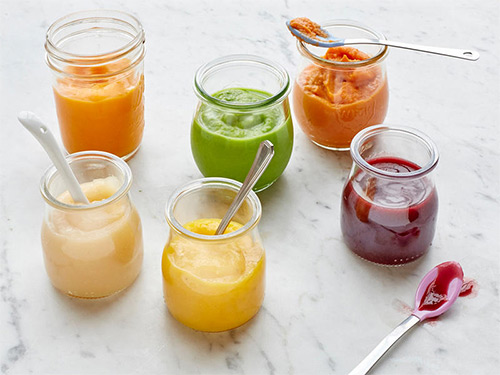
Zucchini, which is considered an easily digestible vegetable, is well suited for new meals. The menu for the week will consist only of him. Then you can offer mashed broccoli. It is good to feed the baby purees consisting of several vegetables. Such dishes are much healthier.
Not all children are delighted with a change in their usual diet. For example, the taste of broccoli leaves much to be desired. You can instill a love for vegetable dishes if you give one spoonful daily, in one or two weeks the baby will be happy to gobble up such useful product. The taste of vegetables will become habitual, and in the future the child will adhere to a healthy diet.
Food cannot be forced to eat. Feeding should take place in a calm, friendly environment.
Continue feeding after vegetables
Now cereals may appear on the feeding table. They begin to give after vegetable dishes. It is better to give preference to those that do not contain milk and gluten. Fortunately, there are plenty of them in stores.
Suitable for cooking, and cereals. Modern store-bought cereals are as balanced as possible and enriched with vitamins and minerals. It is convenient to prepare such products, because it is enough to dilute the contents of the bag with water, and the product is ready for use. From now on, mothers do not have to make sure that the milk does not run away.
Food and allergies

Babies with food intolerances should try new foods at about five months of age. It is necessary to act, as in the case of a completely healthy baby. Parents should use only hypoallergenic products, and in general, the approximate menu for a child with allergies is the same.
The diet may vary depending on the detection of allergens. The first meat dishes should be prepared from turkey or rabbit, as they are well absorbed by the human body.
A well-known pediatrician adheres to the recommendations of the World Health Organization and advises to start complementary foods at about six months of age. The nutrition of the mother up to this age of the child should be healthy, tasty, varied and balanced.
Only then will it allow you to postpone complementary foods for such late deadline, because up to this point, a six-month-old baby will receive everything necessary for growth and development through breast milk. An artificial baby should be fed only with high-quality mixtures.
The doctor recommends paying special attention to the nutrition of a five-month-old baby, since his liver is not yet fully formed and is vulnerable to various kinds of influences. The body does not always cope with the neutralization of harmful substances, which lead to the notorious allergy. The liver is finally formed closer to adolescence.
Experts are of the same opinion about food for an infant. E.O. Komarovsky advises giving preference to fermented milk products, not vegetables. , fermented baked milk, cottage cheese are similar in composition to mixtures and breast milk. For example, kefir improves liver function and promotes digestion. After this fermented milk drink, you can move on to the curds.
After a week and a half, one feeding per day should consist entirely of complementary foods. In parallel, you should continue to feed the baby at 5 months with breast milk and mixtures, if we are talking about crumbs on IV. This scheme should be followed for about one month. In no case should porridges be boiled in milk, as children do not digest animal protein well.
Many women after childbirth are faced with the problem of the appearance of excess weight. For some, they appear during pregnancy, for others - after childbirth.
- And now you can no longer afford to wear open swimsuits and short shorts ...
- You start to forget those moments when men complimented your flawless figure...
- Every time you approach the mirror, it seems to you that the old days will never return ...
The nutrition of a child at 5 months is entirely provided by breast milk or mixtures of the first stage. But now many parents are already thinking about the first complementary foods.
- He is already confidently sitting with support, that is, he can be fed in a high chair;
- Does not push out the spoon with his tongue, but tries to lick it;
- Interested in your food and asks for it;
- She does not eat enough breast milk, she asks for food earlier, the four-hour interval between feedings is not maintained;
- The first tooth erupted.
These signs indicate that the baby is ready to try his first "adult" food.
Feeding children on artificial feeding
Children on artificial feeding traditionally start feeding earlier, as they digestive system before ready for it. However, the issue of underfeeding is not so acute for artificial people - you can simply increase the amount of the mixture. If the baby refuses to eat something other than the usual mixture from the bottle, you can wait a little longer.
Infant nutrition
Breastfed babies may already not have enough milk if he does not fill up, emptying his chest, crying and looking for more. If you notice this, try giving your baby the first solids. For example, pureed vegetables and juices, if the child has excess or normal weight or liquid porridge if underweight. Porridges are used only dairy-free, they can be diluted with mother's milk or a mixture. The menu of a child at 5 months also includes mashed fruits and juices.
Sonya's mom, 7 months old: “It is the restless night sleep told me 2 months ago that my daughter did not have enough food. At first we attributed it to cutting teeth, but she did not refuse breast milk, on the contrary, she constantly asked for breasts. At the next weigh-in, it turned out that she only gained 200 grams and the pediatrician suggested trying porridge or starting to supplement with formula. We began to introduce cereals, and by the next weigh-in, the weight was added according to the norm. ”
Choosing the type of food
The nature of the stool also influences the choice of the first complementary foods. If the stool is too hard, the baby has difficulty pooping, it is better to start with vegetables and fruits, they contain fiber and pectin, which promote bowel movements. Rice porridge is suitable for babies with unstable stools, but prunes, beets, cabbage, apricots do not need to be given to them yet.
How to introduce complementary foods?
It is better to offer new food to the baby at the beginning of the day in order to observe the reaction of the body. First, they give a taste of vegetable puree while the baby is hungry, and then supplement it with milk or formula. Fruit juices, on the contrary, are not given on an empty stomach, they are very acidic. This can lead to regurgitation and indigestion. Juice is best offered after a meal.
Having chosen the type of complementary foods, give it, starting with a teaspoon and bringing this amount to about 50 ml per week (how much the child is ready to eat). The first complementary foods are offered only once a day, it will gradually replace one meal, but it will be later, but for now it will be necessary to supplement the baby with breast or formula. With the introduction next product they are being replaced with other foods.
Juice is also given gradually, starting from a few drops, bringing up to 30 ml. It is not necessary to give more at this age.
Do not introduce a new product if the child is sick, naughty, the chair has deteriorated, teeth are being cut. Also do not give a new product for the first two days after vaccination.
Always keep an eye on your baby. Do not be afraid if the stool changes, this is normal. The main thing is that there is no liquid foaming diarrhea or vomiting. In these cases, cancel this product, take a break for a week and offer the baby another one. Be sure to check with your pediatrician!
Diet plan for a 5 month old baby
How much should a child eat at 5 months breastfed and artificial? We will try to answer these questions.
Important! The volume of menu products is indicated for the finished dish. If you cook 50 g of dry porridge, you will get three times the norm!
Table for 1 day with natural feeding looks like that:
On artificial feeding the amount of food will be slightly less, because. the calorie content of milk formula is higher than breast milk:
The total volume per day is no more than 900 ml, not counting the juice that can be given between lunch and dinner.
Water, herbal tea, decoction of dried fruits are given during the day on demand.
As can be seen from the tables, the daily routine of a child at 5 months includes five meals per day. But a sixth feeding can be added if the baby wakes up at night. By the way, night awakening can also be due to the fact that the child begins to experience hunger. How to find out if this is so? Let's answer the two most important questions:
How much should a 5 month old baby eat?
This amount reaches a liter of milk per day. If such a volume is not recruited, then the baby really does not have enough nutrients.
How much should a baby weigh at 5 months?
Whether a child has enough milk is also judged by weight and height, the WHO table will help with this (these tables are also called Valuable). For the fourth month, boys on average add 430-580 grams, and girls 390-580. In height - 2 and 1.9 cm, respectively. If the weight gain is significantly lower (by 20%), then it is simply necessary to introduce complementary foods.

Table of height and weight of boys, according to WHO:
| Very low |
Short | Below the average | Average | Above average | High | Very tall | |
|---|---|---|---|---|---|---|---|
| The weight | 5.6-6.1 | 6.1-6.5 | 6.5-7.8 | 7.8-8.3 | 8.3-8.8 |
> 8.8
|
|
| Growth | 9.9
|
59
.9 -
61.1
|
61.1 - 62.3
|
62.3 - 65.6
|
65.6-67 | 67-68.9 | > 6 |
Table of height and weight of girls, according to WHO:
| Very low | Short | Below the average | Average | Above average | High | Very tall | |
|---|---|---|---|---|---|---|---|
| The weight | 5.5 - 5.9 |
5.9-6.3 | 6.3-7.2 | 7.2-7.7 | 7.7-8.1 |
> 8.1 |
|
| Growth | 9.1 | 59.1-60.8
|
60.8-62 |
62.
0 - 65.
1 |
65.1-66 | 66.0-68.0 |
> 68.
0 |
According to the norms of the Ministry of Health of the Russian Federation, the minimum weight for girls at this age is 5.9, and the maximum is 7.7 kg. Accordingly, in boys - 6.1–8.3 kg. If we talk about height, then for girls the norm is 60.5-66 cm, and for boys 61-67 cm.

What not to give a baby at five months
The diet of a child at 5 months is rather poor, and rightly so, because the baby's intestines cannot yet digest heavy food. That is why butter and other animal fats are not added to dishes. Exclude salt and sugar, all spices, meat and fish broths. You don't even have to try this yet. You can add a little vegetable oil (for example, flaxseed) to the puree. It is best to dilute mashed potatoes and porridge with mother's milk or a mixture.
Five month old baby menu
Despite the small variety of products, the diet can and should be diversified. What to feed the baby, you need to decide based on his preferences. To do this, they try to give different kinds vegetables and cereals, see what the child likes.
Vegetables
Vegetable complementary foods often start with zucchini. This is a hypoallergenic vegetable, quite tender in texture. Then cauliflower, broccoli, potatoes, and so on are introduced - all green, pale yellow colored vegetables. Brightly colored vegetables: carrots, beets are included in the diet later and are usually mixed with other purees. 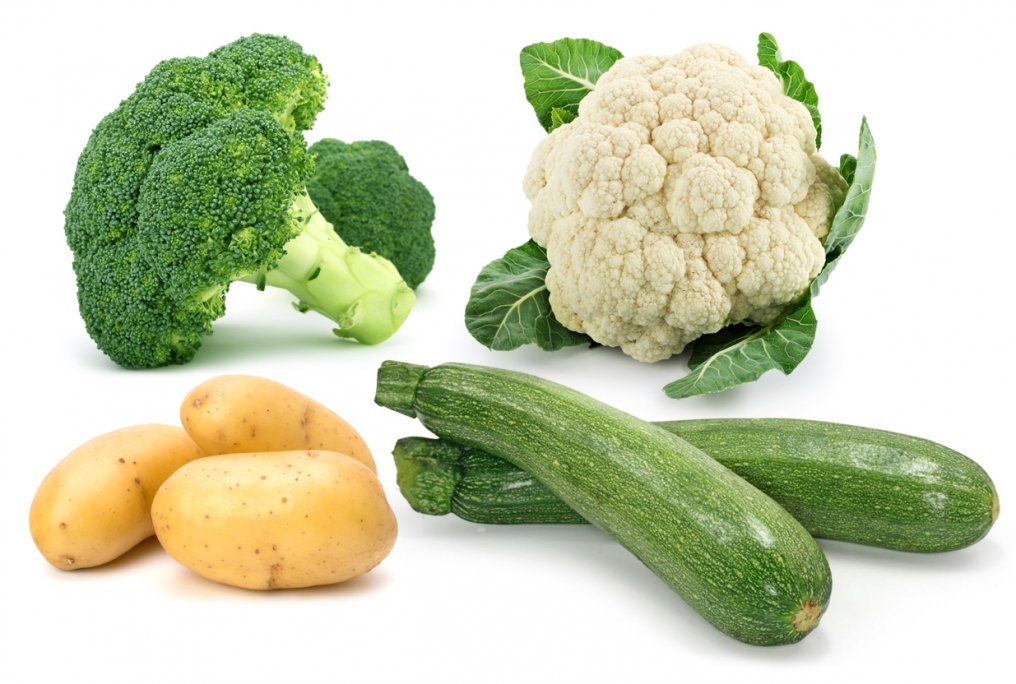
Fruit
Fruits and berries begin to give according to the same principle: from light-colored to dark-colored. Traditionally, the apple comes first, followed by the pear. From tropical fruits, a child at 5 months can only have a banana. With plums, cherries, grapes, it is better to wait up to 6-7 months.
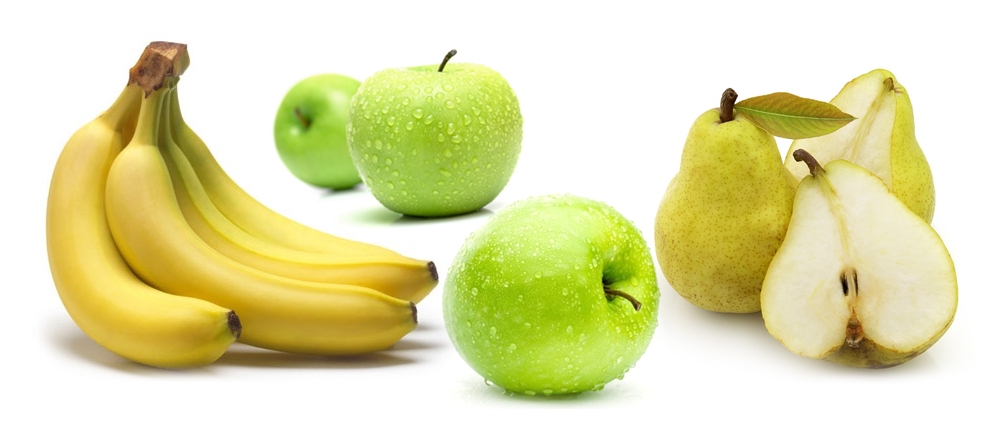
cereals
Of the cereals, those that do not contain gluten are the first to be introduced: rice, buckwheat, millet.
Rules for the introduction of complementary foods
Watch carefully for possible manifestations of allergies. It would be rational to have a special notebook where to write down what was given to the child, what was the reaction, how the stool changed, whether a rash appeared. It is convenient to keep such a notebook at hand or use a notebook with magnets, hanging it on the refrigerator.
Keeping a food diary
Keeping a diary, where the daily routine and nutrition is noted, will not take much time for mom, but she will be able to analyze the information and adjust the menu. Parents often get tired while caring for a child and become distracted. After reading the entry in the diary that there was broccoli for lunch yesterday, mom will not be scared when she sees an unusual color chair.
kitchen utensils
The recipes for all dishes for babies are very simple. To prepare them, it is better to get a sieve, since it is not very convenient to cook such a small amount of food in a blender. Mom will also need a measuring cup and a plastic grater (it is better than a metal grater because it does not oxidize food). Kitchen scales are very helpful, which allow you to measure the right amount of food by weight.
Children's appliances
Some babies have a hard time adjusting to spoon feeding. In this case, liquid 5% porridge can also be given from a bottle. But still, it is necessary to systematically make attempts to switch to feeding in a high chair, from a spoon and learn to drink from a cup. To interest the baby in children's appliances, you may have to try several options. 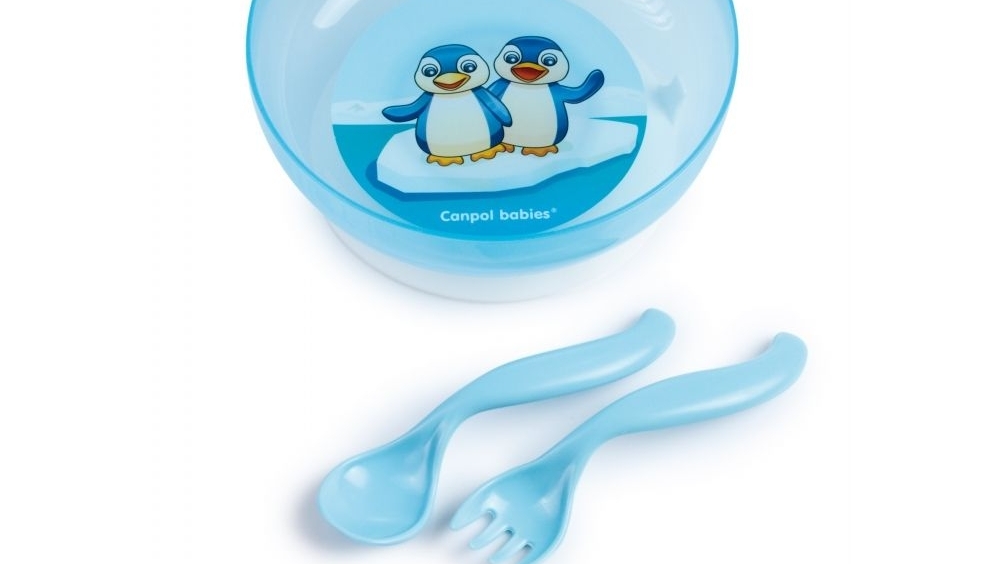
DO NOT store cooked food
Remember that cooked food cannot be stored, even in the refrigerator.
It is better to use less food for cooking. If you are feeding your baby food from jars, then the remains of this food are also not subject to storage.
Homemade food or jars?
Parents are interested in what is still better: cook it yourself or use industrial-made mashed potatoes. In the summer, of course, it is better to use fresh seasonal vegetables and fruits to enrich the diet with vitamins. In winter, you can buy ready-made mashed potatoes. However, chemicals are used to extend the life of puree in a jar, so it is worth using them if there is no time to prepare fresh food. Vegetables and fruits sold in supermarkets in winter are treated with chemicals, traces of which in food can lead to allergies or worsen stools, and there are much fewer useful substances in them. 
In winter, it is rational to buy frozen cauliflower, broccoli, spinach and cook from them. Self-freezing of vegetables is also welcome. If you prudently prepared containers with diced zucchini, pumpkin, in season, then their preparation will take very little time. Adults, including a nursing mother, also do not interfere with fresh vegetable stew in winter.
You can also cook cereals for making cereals yourself by grinding it in a coffee grinder. At the same time, cereals bought in a store must first be washed and dried. Usual dosage: five grams of cereal per hundred milliliters of liquid. Porridges of industrial production are used those in which there is no milk.
Menu table
A sample menu table for the week looks like this:
| Mon | Tue | Wed | Thu | Fri | Sat | Sun | |
|---|---|---|---|---|---|---|---|
| 1 feeding | Breast milk (GM) or adapted formula (AMC) |
GM or AMS | GM or AMS | GM or AMS | GM or AMS |
GM or AMS | GM or AMS |
| 2 feeding | |
Buckwheat and supplementary feeding of GM or AMS | Rice porrige and supplementary feeding of GM or AMS | Buckwheat porridge and supplementary feeding GM or AMC | Corn porridge and supplementary feeding of GM or AMS | ||
| 3 feeding | GM or AMS |
GM or AMS |
GM or AMS |
Broccoli puree, st. oil, supplement GM or AMS |
Zucchini puree, st. oil, supplement GM or AMS |
Cauliflower puree, st. oil, supplement GM or AMS |
Potato puree, st. oil, supplement GM or AMS |
| 4 feeding | Applesauce, supplementary feeding GM or AMS |
Pear puree, supplement GM or AMS |
Banana puree, supplement GM or AMS |
Apple- banana puree, supplement GM or AMS |
Applesauce, supplement GM or AMS |
Apple- pear puree, supplement GM or AMS |
Pear puree, supplement GM or AMS |
| 5 feeding | Breast milk or formula | Breast milk or formula | Breast milk or formula | Breast milk or formula | Breast milk or formula | Breast milk or formula | Breast milk or formula |
10 recipes for babies at five months
1. Apple-banana puree
- 30 g peeled yellow or green apple (1/4 medium apple);
- 30g ripe banana (1/5 medium banana)
- 10 ml mixture or water.
Grate the apple on a fine grater, bring to a uniform state, rubbing through a sieve. Just wipe the banana and dilute the puree with water or a mixture.
2. Pumpkin puree with milk
Cut a piece of pumpkin into small cubes and boil over low heat for 20 minutes. It should become slightly translucent and soft. Rub the vegetable through a sieve. Mix four teaspoons of puree with 50 ml of breast milk, rub again thoroughly. You can add a little water until the desired semi-liquid consistency is reached. 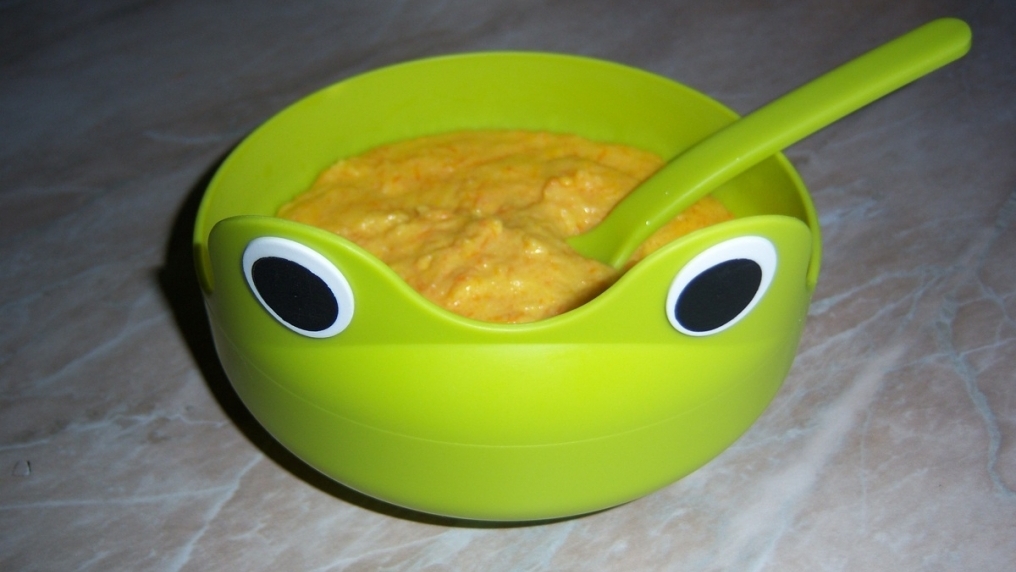
3. Mashed zucchini and broccoli
- 3 broccoli florets;
- 30 g young zucchini, peeled.
Boil vegetables until soft. Drain, save the broth. Turn zucchini and cabbage into puree. Dilute with broth until liquid.
4. Mashed potatoes with white cabbage
A seasonal dish, it is good to cook it when the first young potatoes and cabbage of early varieties appear. Not recommended for food white cabbage late varieties, coarse fiber can lead to increased gas formation.
Peel potatoes and soak in clean water for an hour and a half, so that excess starch comes out of it, which is undesirable for a five-month-old baby.
Boil vegetables, cut into small pieces, in a sealed container until soft. Cool slightly, wipe and dilute with the mixture, breast milk, the remaining broth.
5. Rice porridge with milk
- one heaping teaspoon of rice flour;
- 50 ml of water;
- 50 ml of prepared milk formula, breast milk;
Dissolve rice flour in milk or mixture. Boil water, pour milk with flour in a thin stream and cook until thickened.

6. Buckwheat porridge
1 tsp with a slide of buckwheat flour;
Water - 100 ml;
Pour a teaspoon of flour into hot water and cook until thickened, stirring constantly. Cool slightly, add 1/5 tsp. cold-pressed vegetable oil (optional)
7. Infusion of prunes, regulating stool
It is used with a tendency to constipation, which is typical for artificial children. If such a problem arose in a breast-fed baby, the mother can simply eat the prunes herself.
Rinse 7-8 fruits thoroughly in hot water. Then pour fresh boiling water, close the lid and insist for 18-12 hours. Give the baby two to three teaspoons three times a day. The broth can be kept in the refrigerator for two days after preparation, but to give, bringing to room temperature.
E. O. Komarovsky recommends preparing a decoction of raisins for babies, especially those who are artificially fed. This product contains natural sugars, a large amount of minerals, especially potassium. It is simply necessary in hot weather. summer days when the child sweats a lot.
8. Decoction of raisins
Rinse hot water a tablespoon of raisins, preferably dark varieties. Then pour boiling water (glass), boil for 10 minutes. and let cool. After throwing out the raisins, give the decoction to drink 100 ml per day.
9. Banana porridge
- One heaping teaspoon of rice flour;
- 1/6 of a banana;
- 100 ml of water.
Pour rice flour into hot water and cook until thickened. Put the mashed banana into the prepared porridge and boil for another 1 minute.
10. Herbal tea with a slight anti-inflammatory, diaphoretic and diuretic effect
- ½ tsp chamomile (herb);
- ½ tsp linden (flowers);
- ½ tsp strawberries (leaves).
Herbs pour boiling water (glass) and insist in a sealed container until cool. Strain and give 150-200 ml per day for anxiety, increased gas formation, during the period when teeth are being cut.
Video
